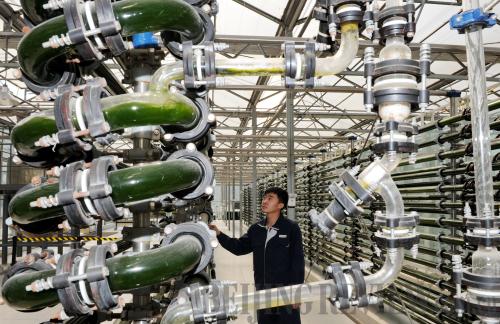|
 |
|
NEW ENERGY: A worker inspects equipment at a coal-based energy zero-emission technology system lab affiliated to ENN Group in Langfang, Hebei Province. Established in 1989, the group offers total solutions for clean energy (YANG SHIYAO) |
Xie said if China did not adopt effective measures during the 12th Five-Year Plan period, the Chinese economy would face more restrictions from resources and the environment.
In China, with the accelerated urbanization and industrialization process, as well as consumption structure upgrading, energy demand is growing rapidly, and economic and social development is increasingly restricted by domestic resources and environment. To prevent a bottleneck in economic development and enhance the capability of sustainable development, China must vigorously boost efforts in energy conservation and emission reduction.
The international competition involved in energy security and climate change has become increasingly fierce. Trade protectionism has risen again, and some developed countries plan to collect carbon tariffs. On the other hand, with the emergence of a green economy and low-carbon technologies, many developed countries are expanding their input in supporting innovation in energy conservation and emission reduction, new energy and low-carbon technologies, which helps intensify competition for future advantages.
"To improve its future economic competitiveness and build up an image of a responsible big power in the international effort to cope with climate change, China must vigorously strengthen its endeavor in saving energy and reducing emissions and realize development in a green and low-carbon way," Xie said.
In China, people's awareness of energy conservation and emission reduction has improved, readjustment of industrial structures has advanced and the capability of scientific innovation has increased. All these have offered favorable conditions to make advances in energy conservation and emission reduction.
The 12th Five-Year Plan on Energy Saving and Emission Reduction imposes strict requirements on energy conservation and emission reduction. According to the plan, related government departments should stop all unapproved high energy consumption and high emission projects under construction, and financial institutions are prohibited from granting loans to such projects. To those unapproved projects that have been completed, production should be stopped, financial institutions should not grant working capital loans to such projects, and water and power supplies should be stopped. The country will strictly control exports of products with high energy consumption, high emissions and high resource consumption. During the 12th Five-Year Plan period, China will eliminate the production capacity of 20 million kw of small thermal power, 48 million tons of iron smelting, 370 million tons of cement production, 42 million tons of coke production and 15 million tons of paper-making.
The plan also illustrates the government's effort to promote development of strategic emerging industries such as energy conservation and environment protection, new-generation information technology, biological technology, high-end equipment manufacturing, new energy, new materials and new-energy vehicles. By 2015, the added value completed by strategic emerging industries will account for 8 percent of the country's GDP.
Sun Lijian, Vice Dean of the School of Economics of Fudan University, said behind strict provisions is the government's hope to combine stabilizing economic growth with economic restructuring, and to promote economic restructuring and transformation of the growth pattern when stabilizing economic growth.
A 2.4-trillion-yuan market
Laiyang's industrial surplus heat reutilization project is only one part of China's energy conservation and emission reduction program. In the 12th Five-Year Plan on Energy Saving and Emission Reduction, the Chinese Government has proposed 10 key projects, including energy-saving transformation of boilers, electric engineering systems, buildings, transportation and green illumination, construction of urban domestic sewage works, prevention and treatment of water pollution in key river basins, desulfurization and denitrification transformation of emissions from power, iron and steel, building materials and auto industries, and prevention and treatment of pollution from livestock breeding, as well as projects that support circular economy development.
The plan says the government will promote the use of high-efficiency and energy-saving home appliances, automobiles, electromotors and illumination products via subsidy grants. During the 12th Five-Year Plan period, 300 million tons of coal equivalent of energy will be saved, while emissions of 4.2 million tons of chemical oxygen demand, 2.77 million tons of sulfur dioxide, 400,000 million tons of ammoniacal nitrogen and 3.58 million tons of nitrogen oxides will be reduced.
According to an estimate by the NDRC, during the five years, the investment in energy conservation and emission reduction projects will total 2.4 trillion yuan ($378.55 billion), of which the investment in key energy conservation projects is 1 trillion yuan ($157.73 billion), that in key pollution and emission reduction projects is 800 billion yuan ($126.18 billion) and that in key circular economy projects is 600 billion yuan ($94.64 billion).
The NDRC said investment needed for projects of energy conservation, the circular economy, prevention and treatment of pollution in key waters as well as desulfurization and denitrification will include capitals raised by enterprises, loans from financial institutions and government funds. Investment in urban sewage works and supporting facilities will mainly come from local governments, and the Central Government will give support to some key projects.
According to a research report by Guodu Securities Co. Ltd., in one or two years, China's investment in key energy conservation and emission reduction projects will boom, with enterprises favored by the market falling into the following several types.
|
